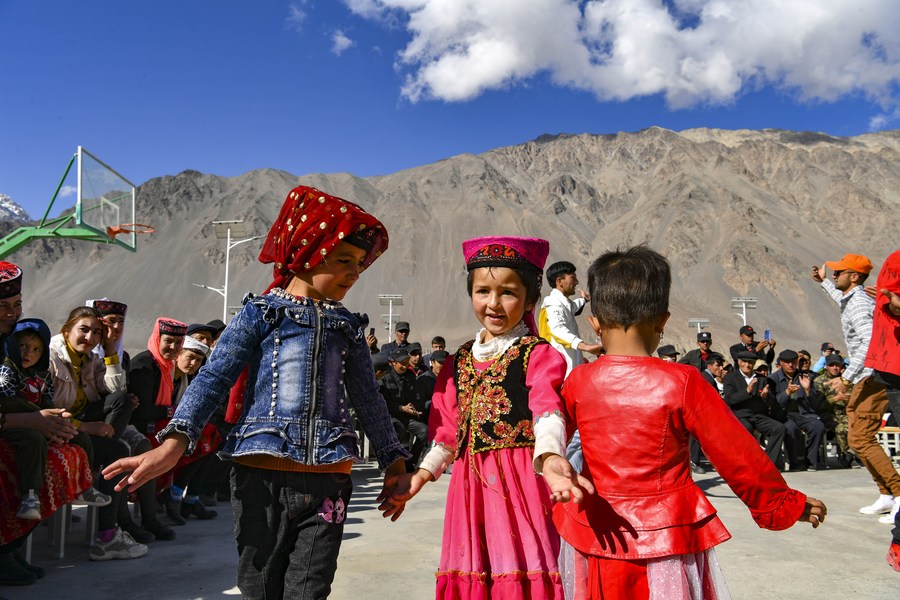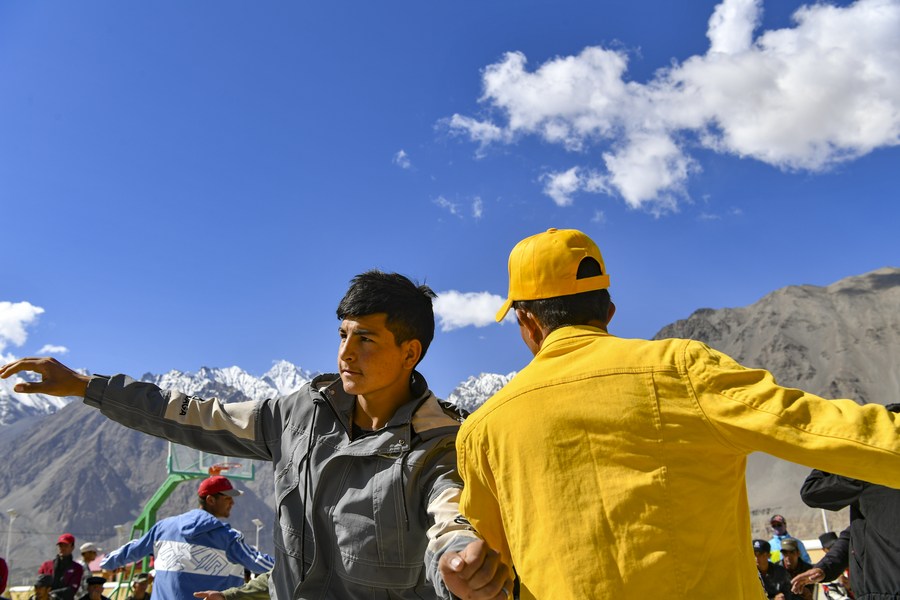
Members of an art troupe in the Taxkorgan Tajik Autonomous County dance in Rasekam Village in northwest China's Xinjiang Uygur Autonomous Region, June 6, 2020. (Xinhua/Hu Huhu)
by Xinhua writers Zhang Zhongkai and Gao Han
URUMQI, July 2 (Xinhua) -- The Pamir Plateau in the far west of northwest China's Xinjiang Uygur Autonomous Region continues to experience snowfall despite the advent of June summers.

An art troupe in the Taxkorgan Tajik Autonomous County is on the way to Rasekam Village, June 5, 2020. (Xinhua/Hu Huhu)
Shareheman Chakuni and his teammates who are members of an art troupe in the Taxkorgan Tajik Autonomous County reached Rasekam Village after driving 204 km through the winding mountainous roads at more than 4,000 meters above the sea level.
On their arrival at the remotest Taxkorgan village, they danced to cheerful beats in front of dozens of audiences. Taxkorgan has a population of roughly 41,000 and is the only autonomous county in China with about 81 percent ethnic Tajik people.

The art troupe puts on a performance in Rasekam Village, June 6, 2020. (Xinhua/Hu Huhu)
The art troupe was founded in 1956 and has retained the tradition of visiting all 40 villages in the county twice a year to entertain the villagers with live performances.
"Every show is like a festival. Everyone joins the dances and shares the joy," said Shareheman.

Combo photo taken on June 5, 2020 shows a vehicle of an art troupe in the Taxkorgan Tajik Autonomous County crossing a river (up) and a troupe member retrieving the license plate which falls into the water when the vehicle crosses the river. (Xinhua/Hu Huhu)
He recalled that the journey to Rasekam used to be arduous as some sections of the road were so narrow and rugged that only camels could travel through. It could take them about a week to reach the village.
Households in the village lived sparsely across 12 valleys until 2017, after which they were relocated together to one of the valleys so that roads and other concentrated infrastructure could be built.
Shareheman said now it takes only five hours to travel from the county seat to Rasekam.

An actor performs the traditional Tajik eagle dance in Rasekam Village, June 6, 2020. (Xinhua/Hu Huhu)
Though all houses in the village have TV sets, the art troupe's live performances remain the most popular attraction as every ethnic Tajik, young or old, enjoys singing and dancing.

Rasekam villagers enjoy the show, June 6, 2020. (Xinhua/Hu Huhu)

Rasekam children dance to the music, June 6, 2020. (Xinhua/Hu Huhu)
In addition to the ethnic folk art, Shareheman and his teammates perform popular art forms from other regions of China like the Peking opera and the clapper ballad.

Actors and actresses perform the clapper ballad in Rasekam Village, June 6, 2020. (Xinhua/Hu Huhu)
The performances have been a way of keeping the villagers informed. Government policies concerning rural people are often made into lyrics and vividly presented to the villagers.

An actress (L) dances with a Rasekam villager, June 6, 2020. (Xinhua/Hu Huhu)
"It's fun and informative," said Imi Mamut, a local villager who recorded several clips of the performances with his smartphone and shared among his friends and on social media platforms. The gala usually lasts for an hour and a half.

Rasekam villagers dance to the music, June 6, 2020. (Xinhua/Hu Huhu)
While local villagers were still reveling in the joyous aura, Shareheman and his teammates were busy packing their props.
"The tour goes on. Those who live in remote regions need us most," Shareheman said, as he prepared to embark on another journey through the snow-capped mountains. ■



